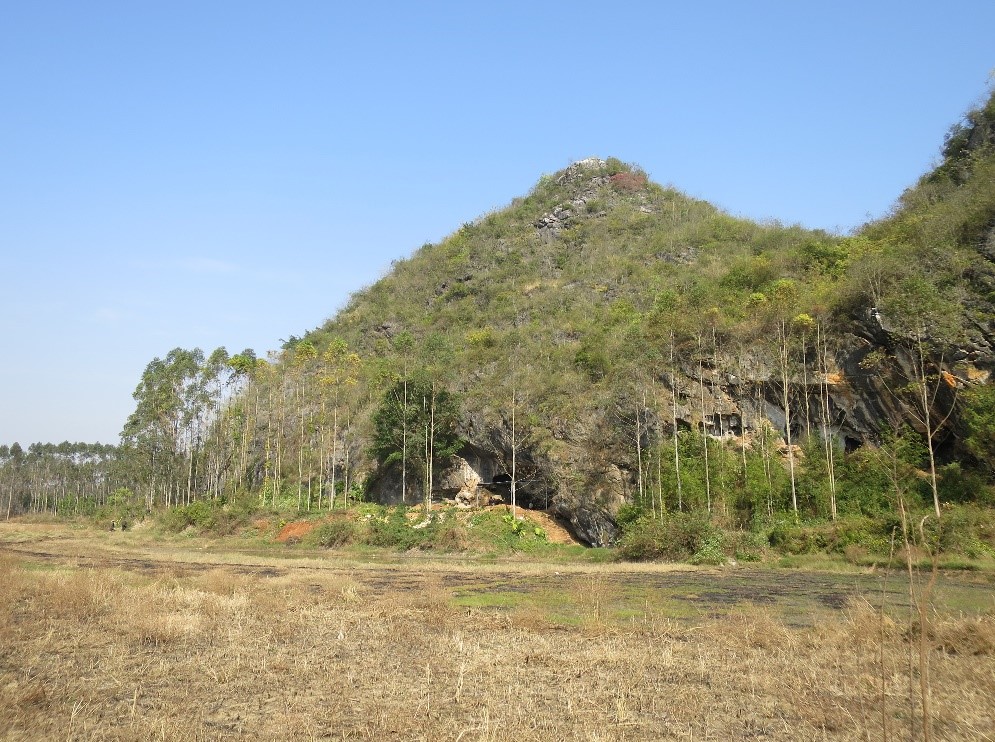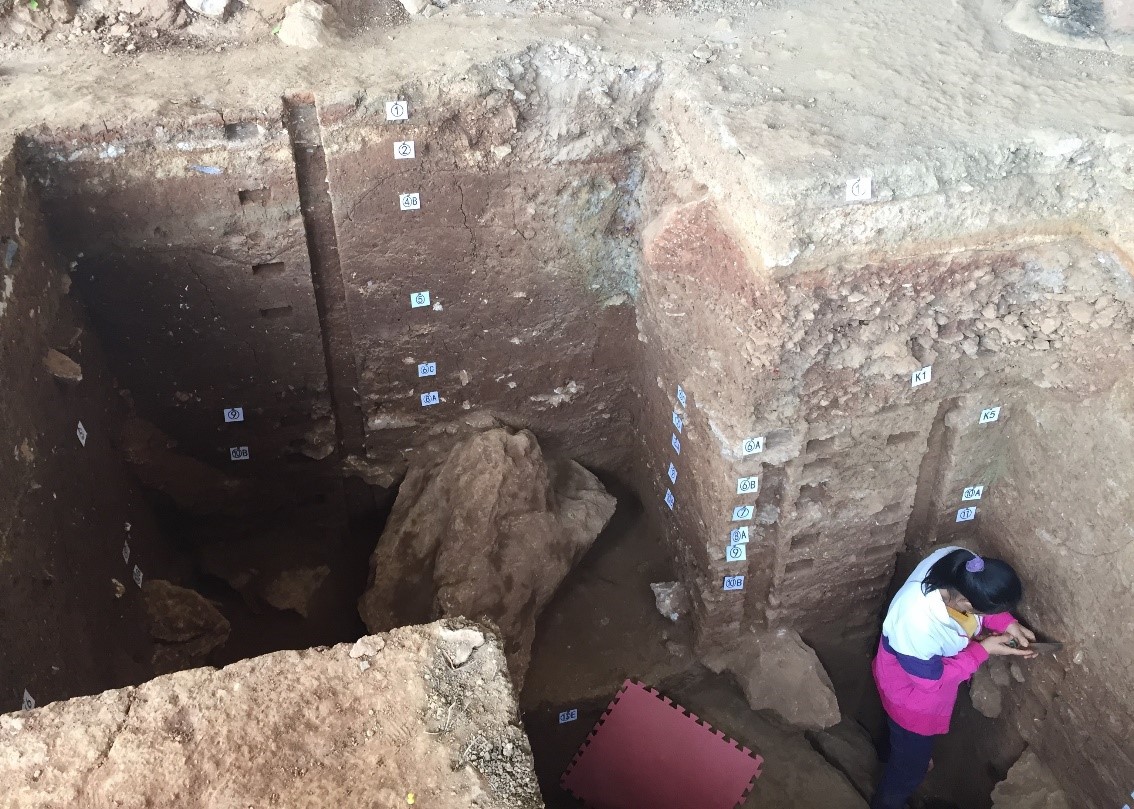Peking University’s Qingtang Site Evacuation Project receives national award
May 07, 2019
Peking University, May 7, 2019: Qingtang Site, jointly excavated by the School of Archaeology and Museology of Peking University and Guangdong Provincial Institute of Cultural Relics and Archaeology, is awarded top 10 new archaeological discoveries in 2018. Over the past three years, the two institutes have engaged in field archaeological work at an excavation area of nearly 60 square meters, from No. 1 Cave of Huangmenyan to No. 4 Cave of Huangmenyan, Qingtang Site, and have been rewarded with important new archaeological discoveries.
The view of Qingtang Site in Yingde, Guangdong Province
Qingtang Site is located in Qingtang Town, Qingyuan City, Guangdong Province. The surrounding karst landform develops and forms a wide eroded valley. Limestone mountain peaks and karst caves abound in Qingtang area. Among them, in the No. 1-4 Cave of Huangmenyan, the prehistoric cultural accumulation, formed from the late Pleistocene to the early Holocene, is best-preserved .
Since June 2016, the School of Archaeology and Museology of Peking University, Guangdong Institute of Cultural Relics and Archaeology, and the Museum of Yingde city have set up field archaeological excavation teams to carry out three-year archaeological excavation and multidisciplinary comprehensive research. In this work, the continuous accumulation of cultural layers from late Pleistocene to early Holocene was found in No. 1-4 Cave of Huangmenyan, Qingtang site. Several relics of the transitional stage of the Paleolithic Age and the Neolithic Age, including tombs and fire relics, were cleared out, and tens of thousands of important relics such as stones, horns, mussels, animal skeletons and early potteries were unearthed.
Archaeological excavation site
The excavation of Qingtang site leads to new understanding of the morphological changes of prehistoric human settlements in Lingnan region from late Late Pleistocene to early Holocene, which is clearly illustrated on No.2 Cave of Huangmenyan. The systematic archaeological excavation and investigation revealed that around 25,000 years ago along with the arrival of the peak of the last glacial period, the mobile hunter-gathers began to occupy several caves in Huangmenyan, leaving behind the first cultural relics feature on stone implement made of siliceous rocks. This stage embodies typical late Paleolithic culture. The relatively thin cultural layers and the scarce remains reflect the social and economic form at that time—high mobility and hunting as the main means of livelihood.
From about 22,000 years ago, the residents of No. 2 Cave began to process the steep-edged gravel tools and formed the second phase of cultural relics. During this period, the cave accumulation was obviously thicker and the cultural relics were abundant, suggesting a stable and long-term residence. With the stable and sustained cave life, to the third and fourth stage of cultural development after 18,000 years ago, the prehistoric inhabitants of Huangmenyan began to use pottery. In addition to hunting mammals, more snails, fish were caught and a large number of plant resources were exploited. This process fully demonstrates that prehistoric human beings in Lingnan region have gradually changed from a mobile forager society to a one in which they settled down and made more use of broad-spectrum resources such as plants and aquatic organisms.
This continuous process of development is the latest interpretation of the transition from the Paleolithic Age to the Neolithic Age, which has puzzled prehistoric scholars for more than half a century in South China. At the press conference on “Top Ten New Archaeological Discoveries in 2018”, some scholars believe that the new discoveries of Qingtang site provide a reliable reference to understand the historical process of the transition of the Paleolithic Age and the Neolithic Age in Lingnan region and its adjacent areas.
The Section of the No.2 Cave Site
Another important discovery at the Qingtang site is the unearthing of many precious ancient human fossils, including human limb and skull fragments lived 20,000 years ago from Cave 2 and a relatively complete young female skeleton from Cave 1, which dates back to 13,500 years ago. The latter is particularly precious. It is the first time that a definite burial type has been found in Paleolithic Archaeology in China. The discovery of these fossils is not only valuable evidence for the study of physical anthropology such as the evolution and diffusion of human beings in the Late Pleistocene in Lingnan region and its adjacent areas, but also the latest information to reveal the spiritual world of human beings at that time and to show the complicated relations between mankind and society in the prehistoric age.
Relics unearthed from the site
Current dating result showed that the main activity time of prehistoric residents at Qingtang site is from 25,000 years ago to 10,000 years ago. The preliminary results of environmental archaeology show that influenced by climate change at the peak of the last glacial period, the site has undergone several cold and warm alternations of varying degrees. The coupling between the climate and environmental changes and Huangmenyan residents’ tool technology, adaptive behaviors and cultural changes, clearly reveal the close relationship between human adaptation strategies in the transitional period of the Paleolithic Age and Neolithic Ages in Lingnan region and the environmental evolution from the end of the Late Pleistocene to the beginning of the Holocene.
The new achievements of important archaeological discoveries at Qingtang site fully demonstrate the importance of close cooperation between universities and local archaeological research institutions in terms of carrying out comprehensive multidisciplinary research. The excavation of Qingtang Site is the first project implemented by the PKU School of Archaeology and Museology and the Guangdong Provincial Institute of Cultural Relics and Archaeology to co-construct the Guangdong Prehistoric Archaeological Practice Base of Peking University. In the course of the project, the intimate cooperation of the two sides facilitates postgraduate training and multidisciplinary research, and lays a solid foundation for the achievement of this significant scientific research.
The new archaeological discovery of Qingtang Site is not only the fulfillment of the postgraduate training, but also the important progress in taking the initiatives to carry out archaeological excavation and research focused on the current major topics of this subject. This achievement solves the bottleneck of the long-term restriction in the historical study of the transition from forager society to agricultural society in Lingnan region and even southern China, and provides significant new materials for the study of settlement patterns in the transitional stage from the Paleolithic Age to the Neolithic Age in South China, the emergence and development of early pottery, the complication of modern human behavior, and the relationship among regional prehistoric cultures, etc.
The discoveries of tombs and human fossils at Qingtang site not only play a vital role in the study of the complex development of burial customs and social relations in the late Paleolithic era, but also provide crucial clues and research directions for major international prehistoric archaeological issues, such as tracing the path of human migration and diffusion since the Late Pleistocene in South China, Southeast Asia and even the Pacific Islands, and searching for the origin of the Austronesian language family.
Written by: Wu Fei
Edited by: Wang Xi & Wang Qian
Source: PKU News (Chinese)



